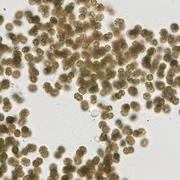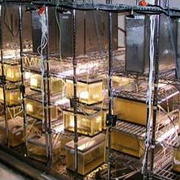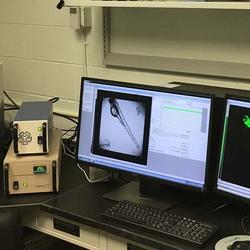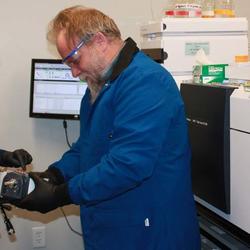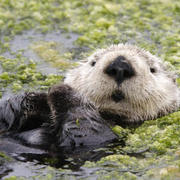Due to a lapse in appropriations, the majority of USGS websites may not be up to date and may not reflect current conditions. Websites displaying real-time data, such as Earthquake and Water and information needed for public health and safety will be updated with limited support. Additionally, USGS will not be able to respond to inquiries until appropriations are enacted. For more information, please see www.doi.gov/shutdown
Contaminant Biology Program
Home
Programs L2 Landing Page
Contaminant Biology Program scientists develop and apply advanced laboratory methods, field investigations, and modeling capabilities to understand toxicity and effects of environmental contaminant exposure. They work jointly with Toxic Substances Hydrology Program Scientists who determine sources, movement, and exposure pathways of contaminants in the environment.
USGS Environmental Health Science, led by the Contaminant Biology and theToxic Substances Hydrology Programs, supports specialized teams of scientists who develop and apply advanced laboratory methods and field investigations to understand how contaminants and pathogens enter and move through the environment and affect the health of insects, fish, wildlife, and domestic animals.
Long-term Studies Examine Contaminant Exposure and Reproduction of Ospreys Nesting in Two Large United States Estuaries
In a series of studies from 2010 to 2018, U.S. Geological Survey (USGS) scientists detected low levels of legacy contaminants and pharmaceuticals in osprey (Pandion haliaetus) and their food chain within the Chesapeake and Delaware River estuaries. Osprey reproductive success increased during the same period and was determined to be adequate to sustain a stable population in both...
Endocrine Disrupting Chemicals and Prevalence of Intersex in Fish Populations in New Jersey
Endocrine Disrupting Chemicals and Prevalence of Intersex in Fish Populations in New Jersey
Understanding Drivers of Cyanotoxin Production in the Lake Okeechobee Waterway
The U.S. Geological Survey (USGS) and other researchers combined field and laboratory approaches in two studies to understand the factors that drive cyanobacterial bloom development and associated cyanotoxin production in Lake Okeechobee, the St. Lucie River and Estuary, and the Indian River Lagoon in response to the large-scale Lake Okeechobee cyanobacteria bloom in 2016.
Prevalence of novel, emerging hepatitis viruses in wild white suckers and their association with liver tumors in the Great Lakes region
Prevalence of novel, emerging hepatitis viruses in wild white suckers and their association with liver tumors in the Great Lakes region
Assessment of the immune status of wild and laboratory-maintained smallmouth bass
Deaths of young-of-year smallmouth bass in the Chesapeake Bay drainage has been noted since 2005. Studies of affected fish have found bacterial, viral and parasitic infections. Mixed infections suggest these fish are immunosuppressed. Understanding the role of specific pathogens and environmental factors that contribute to their presence is important but equally important is the understanding...
Is Uranium in Water Resources near the Grand Canyon a Health Hazard?
The public worries that uranium in natural geologic formations, mine tailings, dusts, water, and other geologic materials can pose a health hazard to humans and wildlife.
Our specialized teams of hydrologists, chemists, and geologists working together at a field site in the Grand Canyon region of the United States have shown:
Elevated uranium concentrations (above the drinking...
Can There be Unintended Benefits when Wastewater Treatment Infrastructure is Upgraded?
Science from the U.S. Geological Survey (USGS) and other entities has shown that a mixture of natural and synthetic estrogens and other similar chemicals are discharged from wastewater treatment plants (WWTPs) to streams and rivers.
USGS and University of Colorado hydrologists, chemists, geologists, and biologists studied the chemistry and biology of Boulder Creek downstream of Boulder ...
Are Spills from Swine Lagoons Causing Downstream Health Hazards?
There are no national databases or tracking of the number or frequency of manure spills in the United States. Some past spills have been shown to result from events such as equipment failures, over-application of manure to agricultural fields, runoff from open feedlots, storage overflow, accidents with manure transporting equipment, severe weather events, or possibly deliberate actions....
What Are the Health Hazards from Contaminants Released to the Environment by Natural Disasters?
Our specialized teams of hydrologists, chemists, and geologists working together at field sites in Northeastern US after Hurricane Sandy have shown:
- Metal contaminants were released to the environment after Hurricane Sandy due to some dune restoration activities.
- In other locations the storm actually decreased contaminant exposures to bottom dwelling aquatic biota. ...
Are Naturally Occurring Microbiological Toxins in Water Resources a Health Hazard?
A growing number of human gastrointestinal, respiratory, dermatologic, and neurologic effects, as well as dog and livestock illnesses and deaths, in the United States have been linked to exposures to algal blooms in recreational lakes and stock ponds.
Some of the blooms contain cyanobacteria, which have the potential to produce cyanotoxins in freshwater systems. However, the connection...
What is the Chemical and Microbial Content of Our Tap Waters?
Safe Drinking Water Act compliance addresses the safety of public-supply water systems. The composition of public-supply drinking water is generally only tested at the treatment plant, and not at the tap after traveling through the water distribution system. Only lead and copper are tested at a subset of residential and other taps. Testing of water in private wells is rare unless local health...
Are Tumors in Wild Fish Harvested in the Great Lakes Region Related to Contaminants in Water Resources?
Our specialized teams of scientists are working in our laboratories and at field sites around the Great Lakes in collaboration with other federal and state resource agencies to document the prevalence of skin and liver tumors. Tumor prevalence in white suckers (Catostomus commersonii), a fish harvested as a food source by local communities, is related to the degree of urbanization in watershed...
White-nose syndrome: cutaneous invasive ascomycosis in hibernating bats
Meteyer, Carol; Verant, MichelleInformation to prevent human exposure to disease agents associated with wildlife—U.S. Geological Survey circulars on zoonotic disease
The U.S. Geological Survey in collaboration with the U.S. Fish and Wildlife Service and others have published reports with information about geographic distribution, specific pathogens, disease ecology, and strategies to avoid exposure and infection for a selection of zoonotic diseases. Zoonotic diseases are diseases that can be passed from...
Meteyer, Carol U.; Moede Rogall, GailContact and contagion: Probability of transmission given contact varies with demographic state in bighorn sheep
Understanding both contact and probability of transmission given contact are key to managing wildlife disease. However, wildlife disease research tends to focus on contact heterogeneity, in part because the probability of transmission given contact is notoriously difficult to measure. Here, we present a first step towards empirically investigating...
Manlove, Kezia R.; Cassirer, E. Frances; Plowright, Raina K.; Cross, Paul C.; Hudson, Peter J.Gene transcription patterns in response to low level petroleum contaminants in Mytilus trossulus from field sites and harbors in southcentral Alaska
The 1989 Exxon Valdez oil spill damaged a wide range of natural resources, including intertidal communities, and post-spill studies demonstrated acute and chronic exposure and injury to an array of species. Standard toxicological methods to evaluate petroleum contaminants have assessed tissue burdens, with fewer assays providing...
Bowen, Lizabeth; Miles, A. Keith; Ballachey, Brenda E.; Waters, Shannon C.; Bodkin, James L.; Lindeberg, Mandy; Esler, Daniel N.Efficacy and residual toxicity of a sodium hydroxide based ballast water treatment system for freshwater bulk freighters
The efficacy and residual toxicity of a sodium hydroxide (NaOH) based ballast water treatment system (BWTS) were tested aboard the Great Lakes carrier M/V American Spiritin 1000 L mesocosms containing water from the ship's ballast tanks. NaOH was added to elevate the pH to 11.5 or 11.7 for 48 h, after which pH...
Elskus, Adria; Mitchelmore, Carys L.; Wright, David; Henquinet, Jeffrey W.; Welschmeyer, Nicholas; Flynn, Colin; Watten, Barnaby J.Maternal transfer of mercury to songbird eggs
We evaluated the maternal transfer of mercury to eggs in songbirds, determined whether this relationship differed between songbird species, and developed equations for predicting mercury concentrations in eggs from maternal blood. We sampled blood and feathers from 44 house wren (Troglodytes aedon) and 34 tree swallow (Tachycineta bicolor) mothers...
Ackerman, Joshua T.; Hartman, C. Alex; Herzog, Mark P.Selenium: Mercury molar ratios in freshwater fish in the Columbia River Basin: Potential applications for specific fish consumption advisories
Fish provide a valuable source of beneficial nutrients and are an excellent source of low fat protein. However, fish are also the primary source of methylmercury exposure in humans. Selenium often co-occurs with mercury and there is some evidence that selenium can protect against mercury toxicity yet States issue fish consumption advisories based...
Cusack, Leanne K.; Eagles-Smith, Collin A.; Harding, Anna K.; Kile, Molly; Stone, DaveWidespread occurrence and potential for biodegradation of bioactive contaminants in Congaree National Park, USA
Organic contaminants with designed molecular bioactivity, such as pesticides and pharmaceuticals, originate from human and agricultural sources, occur frequently in surface waters, and threaten the structure and function of aquatic and terrestrial ecosystems. Congaree National Park in South Carolina (USA) is a vulnerable park unit due to its...
Bradley, Paul M.; Battaglin, William A.; Clark, Jimmy M.; Henning, Frank; Hladik, Michelle L.; Iwanowicz, Luke R.; Journey, Celeste A.; Riley, Jeffrey W.; Romanok, Kristin M.Occurrence and in vitro bioactivity of estrogen, androgen, and glucocorticoid compounds in a nationwide screen of United States stream waters
In vitro bioassays are sensitive, effect-based tools used to quantitatively screen for chemicals with nuclear receptor activity in environmental samples. We measured in vitro estrogen (ER), androgen (AR), and glucocorticoid receptor (GR) activity, along with a broad suite of chemical analytes, in streamwater from 35 well-characterized sites (3...
Conley, Justin M.; Evans, Nicola; Cardon, Mary C.; Rosenblum, Laura; Iwanowicz, Luke R.; Hartig, Phillip C.; Schenck, Kathleen M.; Bradley, Paul M.; Wilson, Vickie S.Geographic and temporal patterns of variation in total mercury concentrations in blood of harlequin ducks and blue mussels from Alaska
We compared total mercury (Hg) concentrations in whole blood of harlequin ducks (Histrionicus histrionicus) sampled within and among two geographically distinct locations and across three years in southwest Alaska. Blue mussels were collected to assess correlation between Hg concentrations in locally available forage and birds. Mercury...
Savoy, Lucas; Flint, Paul L.; Zwiefelhofer, Denny; Brant, Heather; Perkins, Christopher R.; Taylor, Robert J.; Lane, Oksana P.; Hall, Jefferson S.; Evers, David C.; Schamber, JasonMercury and water level fluctuations in lakes of northern Minnesota
Large lake ecosystems support a variety of ecosystem services in surrounding communities, including recreational and commercial fishing. However, many northern temperate fisheries are contaminated by mercury. Annual variation in mercury accumulation in fish has previously been linked to water level (WL) fluctuations, opening the possibility of...
Larson, James H.; Maki, Ryan P.; Christensen, Victoria G.; Sandheinrich, Mark B.; LeDuc, Jaime F.; Kissane, Claire; Knights, Brent C.Importance of the 2014 Colorado River Delta pulse flow for migratory songbirds: Insights from foraging behavior
The Lower Colorado River provides critical riparian areas in an otherwise arid region and is an important stopover site for migrating landbirds. In order to reverse ongoing habitat degradation due to drought and human-altered hydrology, a pulse flow was released from Morelos Dam in spring of 2014, which brought surface flow to dry stretches of the...
Darrah, Abigail J.; Greeney, Harold F.; van Riper, CharlesMolecular Devices ImageXpress† High-Content Imaging System
Molecular Devices ImageXpress† High-Content Imaging System
Molecular Devices ImageXpress† High-Content Imaging System
Molecular Devices ImageXpress† High-Content Imaging System that can generate more than 25,000 images in less than 5 hours of automated image acquisition.
(USGS scientist working on data analysis of cyanotoxins in water
U.S. Geological Survey (USGS) scientist working on data analysis of cyanotoxins in water samples
Keith A. Loftin is the lead scientist for algal and cyanobacteria
Keith A. Loftin, USGS, is the lead scientist for algal and cyanobacterial toxins
USGS scientists evaluating the nebulizer assembly
USGS scientists evaluating the nebulizer assembly in a mixed mode ionization source of a triple quadrupole mass spectrometer used to measure individual cyanotoxins
Eosin-nigrosin staining of spermatozoa from common carp
Eosin-nigrosin staining of spermatozoa from common carp (Cyprinus carpio) testes collected from the Lake Mead National Recreation Area, Nevada
Microscopic video imaging for computerized analysis of sperm motility
Microscopic video imaging is used for computerized analysis of sperm motility parameters
Tablet-enabled field forms have been developed to help field efforts
Tablet-enabled field forms have been developed to help coordinate field efforts, collect site information, GPS coordinates, photos, and control data collection.
A USGS scientist prepares a sample to test the effect of antibiotics
A USGS scientist prepares a sample to test the effect of antibiotics on denitrifying bacteria within a glove box. A glove box allows scientists to work with samples in an anaerobic (no oxygen) atmosphere, the conditions under which denitrification occurs.
Using the 384-well plate format, a single zebrafish embryo is tested
Using the 384-well plate format, a single zebrafish embryo is tested in each well. This is an example of a 72 hour post fertilization fli1:egfp zebrafish (3 millimeters long) imaged under a fluorescein isothiocyanate (FITC) filter.
Scientist Sitting Next to a Biological Safety Cabinet in a Laboratory
A U.S. Geological Survey scientist sits next to a biological safety cabinet in the cell bioassay laboratory at Columbia Environmental Research Center. Scientists optimized existing endocrine active chemical screening tests to improve their precision, accuracy, and
...High-Content Screening Laboratory -- Columbia, Missouri
High-Content Screening Laboratory -- Columbia, Missouri
In addition to news release about our latest papers we also provide Environmental Health Featured Science Activities that highlight the results of our investigations.
See Our Featured Science ActivitiesIdentifying Potential Contaminant Exposure to California Condors in the Pacific Northwest
Potential reintroduction of the endangered California Condor to parts of its historic range in the Pacific Northwest would benefit from information on possible threats that could challenge recovery efforts. Exposure to environmental contaminants is a key limiting factor for condor recovery in its southern range.
What’s New in Fiscal Year 2019
Information on funding for Environmental Health Mission Area programs for fiscal year 2019.
Highlights of Fiscal Year 2017 Accomplishments
"Everything we do is designed to safeguard the Nation's health, economy, and resources."
A summary of accomplishments for fiscal year 2017 for the Environmental Health Mission Area.
In Orlando, USGS Science on the Health of the Environment is on Display
Studies on the aquatic food web, tree swallows, and the spread of contaminants take center stage at SETAC 2016.
When the Whole is Less than the Sum of Its Parts
Environmental Ratios of Cadmium and Zinc are less Toxic to Aquatic Insects than Expected
Comprehensive Study finds Widespread Mercury Contamination Across Western North America
Mercury contamination is widespread, at various levels across western North America in air, soil, sediment, plants, fish and wildlife.
EarthWord–Morbidity
When you’re not dead yet, but aren’t feeling well either, there’s an EarthWord for that...
Evidence of Unconventional Oil and Gas Wastewater Found in Surface Waters near Underground Injection Site
These are the first published studies to demonstrate water-quality impacts to a surface stream due to activities at an unconventional oil and gas wastewater deep well injection disposal site.
Despite Long-Lasting Pollutants, Ospreys Thrive in US’ Largest Estuary
The world's largest breeding population of ospreys is coping well with the long-lasting residues of toxic chemicals that were banned decades ago but remain in the Chesapeake Bay food chain at varying levels, such as the pesticide DDT and insulating chemicals known as PCBs.
EarthWord – Medical Geology
Medical Geology is an earth science specialty that concerns how geologic materials and earth processes affect human health.
Mercury and Selenium are Accumulating in the Colorado River Food Web of the Grand Canyon
Although the Grand Canyon segment of the Colorado River features one of the most remote ecosystems in the United States, it is not immune to exposure from toxic chemicals such as mercury according to newly published research in Environmental Toxicology and Chemistry.
Insecticides Similar to Nicotine Found in about Half of Sampled Streams across the United States
USGS discovered insecticides known as neonicotinoids in a little more than half of both urban and agricultural streams sampled across the United States and Puerto Rico, according to a study by the agency published today inEnvironmental Chemistry.
Keep up with our science by subscribing to the GeoHealth Newsletter.
Get the Newsletter








